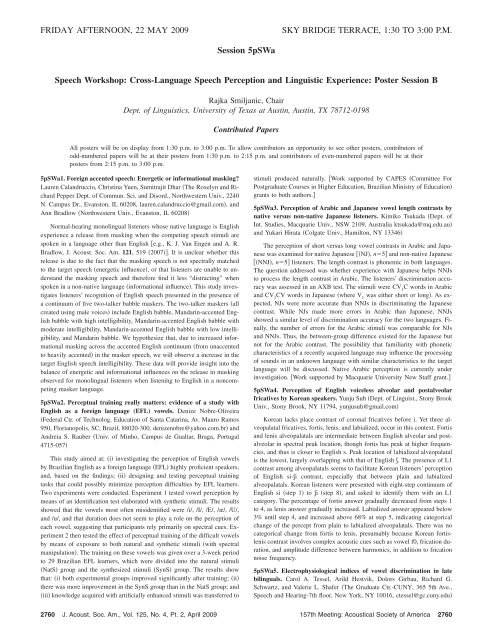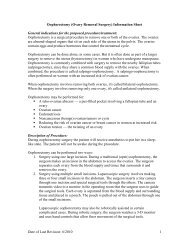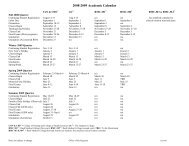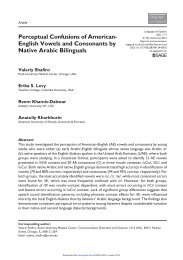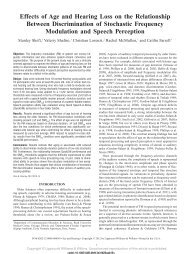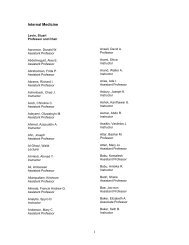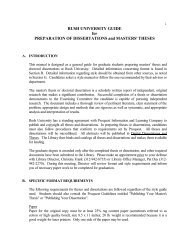Perceptual confusions of American English vowels ... - Rush University
Perceptual confusions of American English vowels ... - Rush University
Perceptual confusions of American English vowels ... - Rush University
Create successful ePaper yourself
Turn your PDF publications into a flip-book with our unique Google optimized e-Paper software.
FRIDAY AFTERNOON, 22 MAY 2009<br />
SKY BRIDGE TERRACE, 1:30 TO 3:00 P.M.<br />
Session 5pSWa<br />
Speech Workshop: Cross-Language Speech Perception and Linguistic Experience: Poster Session B<br />
Rajka Smiljanic, Chair<br />
Dept. <strong>of</strong> Linguistics, <strong>University</strong> <strong>of</strong> Texas at Austin, Austin, TX 78712-0198<br />
Contributed Papers<br />
All posters will be on display from 1:30 p.m. to 3:00 p.m. To allow contributors an opportunity to see other posters, contributors <strong>of</strong><br />
odd-numbered papers will be at their posters from 1:30 p.m. to 2:15 p.m. and contributors <strong>of</strong> even-numbered papers will be at their<br />
posters from 2:15 p.m. to 3:00 p.m.<br />
5pSWa1. Foreign accented speech: Energetic or informational masking<br />
Lauren Calandruccio, Christina Yuen, Sumitrajit Dhar The Roxelyn and Richard<br />
Pepper Dept. <strong>of</strong> Commun. Sci. and Disord., Northwestern Univ., 2240<br />
N. Campus Dr., Evanston, IL 60208, lauren.calandruccio@gmail.com, and<br />
Ann Bradlow Northwestern Univ., Evanston, IL 60208<br />
Normal-hearing monolingual listeners whose native language is <strong>English</strong><br />
experience a release from masking when the competing speech stimuli are<br />
spoken in a language other than <strong>English</strong> e.g., K. J. Van Engen and A. R.<br />
Bradlow, J. Acoust. Soc. Am. 121, 519 2007. It is unclear whether this<br />
release is due to the fact that the masking speech is not spectrally matched<br />
to the target speech energetic influence, or that listeners are unable to understand<br />
the masking speech and therefore find it less “distracting” when<br />
spoken in a non-native language informational influence. This study investigates<br />
listeners’ recognition <strong>of</strong> <strong>English</strong> speech presented in the presence <strong>of</strong><br />
a continuum <strong>of</strong> five two-talker babble maskers. The two-talker maskers all<br />
created using male voices include <strong>English</strong> babble, Mandarin-accented <strong>English</strong><br />
babble with high intelligibility, Mandarin-accented <strong>English</strong> babble with<br />
moderate intelligibility, Mandarin-accented <strong>English</strong> babble with low intelligibility,<br />
and Mandarin babble. We hypothesize that, due to increased informational<br />
masking across the accented <strong>English</strong> continuum from unaccented<br />
to heavily accented in the masker speech, we will observe a increase in the<br />
target <strong>English</strong> speech intelligibility. These data will provide insight into the<br />
balance <strong>of</strong> energetic and informational influences on the release in masking<br />
observed for monolingual listeners when listening to <strong>English</strong> in a noncompeting<br />
masker language.<br />
5pSWa2. <strong>Perceptual</strong> training really matters: evidence <strong>of</strong> a study with<br />
<strong>English</strong> as a foreign language (EFL) <strong>vowels</strong>. Denize Nobre-Oliveira<br />
Federal Ctr. <strong>of</strong> Technolog. Education <strong>of</strong> Santa Catarina, Av. Mauro Ramos<br />
950, Florianopolis, SC, Brazil, 88020-300, denizenobre@yahoo.com.br and<br />
Andreia S. Rauber Univ. <strong>of</strong> Minho, Campus de Gualtar, Braga, Portugal<br />
4715-057<br />
This study aimed at: i investigating the perception <strong>of</strong> <strong>English</strong> <strong>vowels</strong><br />
by Brazilian <strong>English</strong> as a foreign language EFL highly pr<strong>of</strong>icient speakers,<br />
and, based on the findings; ii designing and testing perceptual training<br />
tasks that could possibly minimize perception difficulties by EFL learners.<br />
Two experiments were conducted. Experiment 1 tested vowel perception by<br />
means <strong>of</strong> an identification test elaborated with synthetic stimuli. The results<br />
showed that the <strong>vowels</strong> most <strong>of</strong>ten misidentified were /i/, /I/, /E/, /æ/, /U/,<br />
and /u/, and that duration does not seem to play a role on the perception <strong>of</strong><br />
each vowel, suggesting that participants rely primarily on spectral cues. Experiment<br />
2 then tested the effect <strong>of</strong> perceptual training <strong>of</strong> the difficult <strong>vowels</strong><br />
by means <strong>of</strong> exposure to both natural and synthetic stimuli with spectral<br />
manipulation. The training on these <strong>vowels</strong> was given over a 3-week period<br />
to 29 Brazilian EFL learners, which were divided into the natural stimuli<br />
NatS group and the synthesized stimuli SynS group. The results show<br />
that: i both experimental groups improved significantly after training; ii<br />
there was more improvement in the SynS group than in the NatS group; and<br />
iii knowledge acquired with artificially enhanced stimuli was transferred to<br />
stimuli produced naturally. Work supported by CAPES Committee For<br />
Postgraduate Courses in Higher Education, Brazilian Ministry <strong>of</strong> Education<br />
grants to both authors.<br />
5pSWa3. Perception <strong>of</strong> Arabic and Japanese vowel length contrasts by<br />
native versus non-native Japanese listeners. Kimiko Tsukada Dept. <strong>of</strong><br />
Int. Studies, Macquarie Univ., NSW 2109, Australia ktsukada@mq.edu.au<br />
and Yukari Hirata Colgate Univ., Hamilton, NY 13346<br />
The perception <strong>of</strong> short versus long vowel contrasts in Arabic and Japanese<br />
was examined for native Japanese NJ, n5 and non-native Japanese<br />
NNJ, n5 listeners. The length contrast is phonemic in both languages.<br />
The question addressed was whether experience with Japanese helps NNJs<br />
to process the length contrast in Arabic. The listeners’ discrimination accuracy<br />
was assessed in an AXB test. The stimuli were CV 1<br />
C words in Arabic<br />
and CV 1<br />
CV words in Japanese where V 1<br />
was either short or long. As expected,<br />
NJs were more accurate than NNJs in discriminating the Japanese<br />
contrast. While NJs made more errors in Arabic than Japanese, NNJs<br />
showed a similar level <strong>of</strong> discrimination accuracy for the two languages. Finally,<br />
the number <strong>of</strong> errors for the Arabic stimuli was comparable for NJs<br />
and NNJs. Thus, the between-group difference existed for the Japanese but<br />
not for the Arabic contrast. The possibility that familiarity with phonetic<br />
characteristics <strong>of</strong> a recently acquired language may influence the processing<br />
<strong>of</strong> sounds in an unknown language with similar characteristics to the target<br />
language will be discussed. Native Arabic perception is currently under<br />
investigation. Work supported by Macquarie <strong>University</strong> New Staff grant.<br />
5pSWa4. Perception <strong>of</strong> <strong>English</strong> voiceless alveolar and postalveolar<br />
fricatives by Korean speakers. Yunju Suh Dept. <strong>of</strong> Linguist., Stony Brook<br />
Univ., Stony Brook, NY 11794, yunjusuh@gmail.com<br />
Korean lacks place contrast <strong>of</strong> coronal fricatives before i. Yet three alveopalatal<br />
fricatives, fortis, lenis, and labialized, occur in this context. Fortis<br />
and lenis alveopalatals are intermediate between <strong>English</strong> alveolar and postalveolar<br />
in spectral peak location, though fortis has peak at higher frequencies,<br />
and thus is closer to <strong>English</strong> s. Peak location <strong>of</strong> labialized alveopalatal<br />
is the lowest, largely overlapping with that <strong>of</strong> <strong>English</strong> b. The presence <strong>of</strong> L1<br />
contrast among alveopalatals seems to facilitate Korean listeners’ perception<br />
<strong>of</strong> <strong>English</strong> si-bi contrast, especially that between plain and labialized<br />
alveopalatals. Korean listeners were presented with eight-step continuum <strong>of</strong><br />
<strong>English</strong> si step 1 to bi step 8, and asked to identify them with an L1<br />
category. The percentage <strong>of</strong> fortis answer gradually decreased from steps 1<br />
to 4, as lenis answer gradually increased. Labialized answer appeared below<br />
3% until step 4, and increased above 68% at step 5, indicating categorical<br />
change <strong>of</strong> the percept from plain to labialized alveopalatals. There was no<br />
categorical change from fortis to lenis, presumably because Korean fortislenis<br />
contrast involves complex acoustic cues such as vowel f0, frication duration,<br />
and amplitude difference between harmonics, in addition to frication<br />
noise frequency.<br />
5pSWa5. Electrophysiological indices <strong>of</strong> vowel discrimination in late<br />
bilinguals. Carol A. Tessel, Arild Hestvik, Dolors Girbau, Richard G.<br />
Schwartz, and Valerie L. Shafer The Graduate Ctr.-CUNY, 365 5th Ave.,<br />
Speech and Hearing-7th floor, New York, NY 10016, ctessel@gc.cuny.edu<br />
2760 J. Acoust. Soc. Am., Vol. 125, No. 4, Pt. 2, April 2009 157th Meeting: Acoustical Society <strong>of</strong> America 2760


